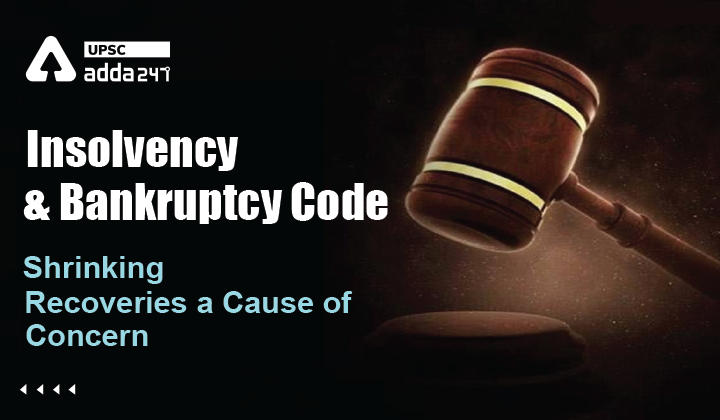Table of Contents
Insolvency and Bankruptcy Code UPSC: Relevance
- GS 3: Indian Economy and issues relating to planning, mobilization, of resources, growth, development and employment.
Insolvency and Bankruptcy Code: Context
- According to the data published by the Insolvency and Bankruptcy Board of India (IBBI), recoveries by financial creditors shrank by 39.3 per cent as of March 2021, and was as high as 46 per cent till March 2020.
Shrinking recoveries in IBC: Key points
- Recoveries by financial regulators have dropped significantly in the past two years owing to the pandemic, resulting in larger haircuts for them.
- A haircut, in the context of loan recoveries, is the difference between the actual dues from a borrower and the amount he settles with the bank.
- Recoveries, however, are still higher than the other measures.
- The number of new cases admitted under the insolvency process has also gone down in FY22, with only 834 cases admitted as against 2,000 cases in FY20.
Reasons for drop in recoveries
- COVID induced lockdown caused loss of investor appetite for stressed assets
- Delays in resolution process due to legal battles not only in Law Tribunal and National Company Law Appellate Tribunal, but also high courts of India.
- Some of the corporate debtors had seen substantial value erosion, which impacts recovery for financial creditors.
What is Insolvency and Bankruptcy Code?
- The Insolvency and Bankruptcy Code, 2016 (IBC) was enacted in 2016, to reduce the mounting non-performing loans.
- IBC was expected to establish a consolidated framework for insolvency resolution of corporations, partnership firms and individuals in a time-bound manner.
- The IBC Code seeks to tackle the non-performing asset (NPA) problem in two ways.
- Firstly, behavioural change on part of the debtors to ensure sound business decision-making and prevent business failures is encouraged.
- Secondly, it envisages a process through which financially ailing corporate entities are put through a rehabilitation process and brought back up on their feet.
- Under the IBC, the Indian insolvency regime shifted from ‘debtor-in-possession’ to ‘creditor-in-control’.
- The creditor-in-control model hands control of the debtor to its creditors and relies upon the managerial skills of a newly appointed management to take over an ailing company and ensure business continuance.
Read current affairs for UPSC





 TSPSC Group 1 Question Paper 2024, Downl...
TSPSC Group 1 Question Paper 2024, Downl...
 TSPSC Group 1 Answer key 2024 Out, Downl...
TSPSC Group 1 Answer key 2024 Out, Downl...
 UPSC Prelims 2024 Question Paper, Downlo...
UPSC Prelims 2024 Question Paper, Downlo...




